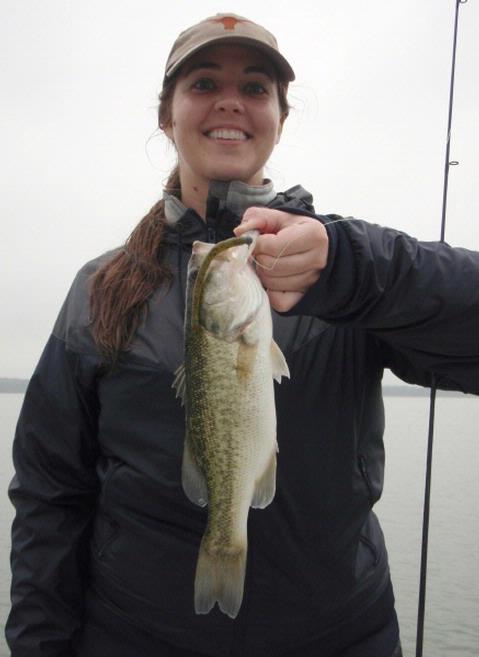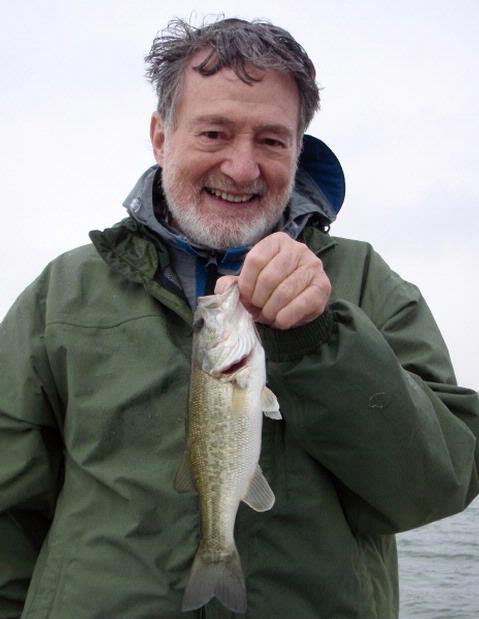I fished a half-day morning trip with returning guests Jim and Shena S. of Austin today. On two previous trips Jim and Shena enjoyed some mixed bag angling, with much of our catch consisting of white bass taken on blade baits, live shad, and jigging spoons. Although they enjoyed this fishing tremendously, it wasn’t a kind of angling they could take back to their “home lake” and replicate. So, their request of me today was to familiarize them with some classic largemouth bass fishing techniques designed for bass hiding in cover that would equip them to do well upon their return home.

Shena was the first to hit paydirt with the jigworm this morning…

…and Jim got an “eleveth hour” largemouth off a rocky outcropping just shortly before noon.
Start Time: 7:00a
End Time: 1:30p
Air Temp: 68F at trip’s start.
Water Surface Temp: ~66.4F
Wind: Winds were from the E at ~10-12 the entire trip .
Skies: Skies were leaden grey the entire trip with rain falling pre-dawn, and occasional sprinkles thereafter.
As we got underway, we began up in shallow cover where brush, trees, lay-down logs, etc. were the cover type I expected to find bass in. It soon became apparent that the accuracy required to land baits consistently in the nooks and crannies the bass hide in was going to be beyond Jim and Shena’s ability level at this point. I suggested to them, as I do many beginning anglers looking to truly improve there abilities, to begin practice casting at home, then take those polished skills onto the water. A few pointers for doing this and making the most of it include: 1) practicing with the same gear you intend to use on the water, 2) using the same lure or lures you’re likely to use on the water (so the weight, wind resistance, etc. is all familiar to you), 3) an inverted garbage can lid makes an ideal target, and 4) vary your distance and your position relative to the wind (i.e. cast upwind, downwind, cross-wind, etc.).
This made sense to them, and we regrouped a bit and moved on to work some areas where accuracy wasn’t as critical. We hit a number of areas, moving on if no action was immediately forthcoming, or lingering a while if action came quickly. We used jig-worms at Areas 420, 421, 422, 386, 423 to 246, 399 and 777 and by the end of the day had managed 6 largemouth bass. Of course in my mind I’m always looking for correlations or common denominators as to what is producing. The areas that gave up fish today all had solid limestone as a bottom substrate, were in fairly clear water, and we found the fish in 7-8 feet with nearby access to deeper water (Areas 420, 421 (2 fish), 422, 423, and 246).
This 6 fish day was a much lower catch rate than over our past two trips, but I let Jim and Shena know ahead of time to expect just that. Working soft plastics can be a bit tedious and requires full, constant concentration.
As Jim said at the outset, “I’m not paying to catch fish, I’m paying for a fishing seminar.” And I tried to provide just that.
By day’s end we’d practiced spinnerbaiting, Texas rigging, and jig-worming and discussed a host of other tactics beyond that. After coming off the water, Jim pulled out a stack of 3×5 cards from his jacket, each had a neatly written question about tactics, terms, conditions, etc. that he had questions about. We peeled off our rain gear, leaned against the boat in the parking lot, and went card by card until all of his questions we hadn’t already addressed on the water were answered.
TALLY = 6 FISH, all caught and released

